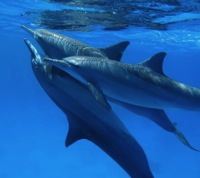Difference between revisions of "Dolphins"
m (Text replacement - "http://nordan.daynal.org" to "https://nordan.daynal.org") |
m (Text replacement - "http://" to "https://") |
||
| Line 3: | Line 3: | ||
==Origin== | ==Origin== | ||
[https://nordan.daynal.org/wiki/index.php?title=English#ca._1100-1500_.09THE_MIDDLE_ENGLISH_PERIOD Middle English] ''delphyn'', ''dolphyn'', from Anglo-French ''delphin'', alteration of Old French ''dalfin'', from Medieval Latin ''dalfinus'', alteration of Latin ''delphinus'', from [[Greek]] ''delphin''-, ''delphis''; akin to [[Greek]] ''delphys'' [[womb]], [[Sanskrit]] ''garbha'' | [https://nordan.daynal.org/wiki/index.php?title=English#ca._1100-1500_.09THE_MIDDLE_ENGLISH_PERIOD Middle English] ''delphyn'', ''dolphyn'', from Anglo-French ''delphin'', alteration of Old French ''dalfin'', from Medieval Latin ''dalfinus'', alteration of Latin ''delphinus'', from [[Greek]] ''delphin''-, ''delphis''; akin to [[Greek]] ''delphys'' [[womb]], [[Sanskrit]] ''garbha'' | ||
| − | *[ | + | *[https://en.wikipedia.org/wiki/14th_century 14th Century] |
The name is originally from [[Greek]] δελφίς (''delphís''), "dolphin", which was related to the Greek δελφύς (''delphus''), "[[womb]]". The animal's name can therefore be [[interpreted]] as meaning "a 'fish' with a womb". The name was transmitted via the [[Latin]] ''delphinus'' (the romanization of the later Greek δελφῖνος – ''delphinos''), which in Medieval Latin became ''dolfinus'' and in Old French ''daulphin'', which reintroduced the ph into the [[word]]. The term ''mereswine'' (that is, "sea pig") has also historically been used. | The name is originally from [[Greek]] δελφίς (''delphís''), "dolphin", which was related to the Greek δελφύς (''delphus''), "[[womb]]". The animal's name can therefore be [[interpreted]] as meaning "a 'fish' with a womb". The name was transmitted via the [[Latin]] ''delphinus'' (the romanization of the later Greek δελφῖνος – ''delphinos''), which in Medieval Latin became ''dolfinus'' and in Old French ''daulphin'', which reintroduced the ph into the [[word]]. The term ''mereswine'' (that is, "sea pig") has also historically been used. | ||
<center>For lessons on the [[topic]] of '''''Dolphins''''', follow [https://nordan.daynal.org/wiki/index.php?title=Category:Dolphins '''''this link'''''].</center> | <center>For lessons on the [[topic]] of '''''Dolphins''''', follow [https://nordan.daynal.org/wiki/index.php?title=Category:Dolphins '''''this link'''''].</center> | ||
The word is used in a few different ways. It can mean: | The word is used in a few different ways. It can mean: | ||
| − | *any member of the family [ | + | *any member of the family [https://en.wikipedia.org/wiki/Oceanic_dolphin Delphinidae] (oceanic dolphins), |
| − | *any member of the family Delphinidae or the superfamily [ | + | *any member of the family Delphinidae or the superfamily [https://en.wikipedia.org/wiki/River_dolphin Platanistoidea] (oceanic and river dolphins), |
| − | *any member of the suborder [ | + | *any member of the suborder [https://en.wikipedia.org/wiki/Odontoceti Odontoceti] (toothed whales; these include the above families and some others), |
| − | *and is used casually as a synonym for [ | + | *and is used casually as a synonym for [https://en.wikipedia.org/wiki/Bottlenose_dolphin bottlenose dolphin], the most common and familiar species of dolphin. |
==Description== | ==Description== | ||
| − | '''Dolphins''' are marine [[mammals]] closely related to [ | + | '''Dolphins''' are marine [[mammals]] closely related to [https://en.wikipedia.org/wiki/Whale whales] and [https://en.wikipedia.org/wiki/Porpoise porpoises]. There are almost forty species of dolphin in 17 genera. They vary in size from 1.2 m (4 ft) and 40 kg (90 lb) ([https://en.wikipedia.org/wiki/Maui%27s_dolphin Maui's dolphin]), up to 9.5 m (30 ft) and 10 tonnes (9.8 long tons; 11 short tons) (the [https://en.wikipedia.org/wiki/Killer_whale orca] or killer whale). They are found worldwide, mostly in the shallower seas of the [https://en.wikipedia.org/wiki/Continental_shelves continental shelves], and are carnivores, eating mostly fish and squid. The family [https://en.wikipedia.org/wiki/Oceanic_dolphin Delphinidae] is the largest in the [https://en.wikipedia.org/wiki/Cetacea Cetacean] order, and evolved relatively recently, about ten million years ago, during the [https://en.wikipedia.org/wiki/Miocene Miocene]. Dolphins are among the most [[intelligent]] animals, and their often [[friendly]] appearance and seemingly [[playful]] [[attitude]] have made them popular in human culture.[https://en.wikipedia.org/wiki/Dolphin] |
[[Category: Biology]] | [[Category: Biology]] | ||
Latest revision as of 00:09, 13 December 2020
Origin
Middle English delphyn, dolphyn, from Anglo-French delphin, alteration of Old French dalfin, from Medieval Latin dalfinus, alteration of Latin delphinus, from Greek delphin-, delphis; akin to Greek delphys womb, Sanskrit garbha
The name is originally from Greek δελφίς (delphís), "dolphin", which was related to the Greek δελφύς (delphus), "womb". The animal's name can therefore be interpreted as meaning "a 'fish' with a womb". The name was transmitted via the Latin delphinus (the romanization of the later Greek δελφῖνος – delphinos), which in Medieval Latin became dolfinus and in Old French daulphin, which reintroduced the ph into the word. The term mereswine (that is, "sea pig") has also historically been used.
The word is used in a few different ways. It can mean:
- any member of the family Delphinidae (oceanic dolphins),
- any member of the family Delphinidae or the superfamily Platanistoidea (oceanic and river dolphins),
- any member of the suborder Odontoceti (toothed whales; these include the above families and some others),
- and is used casually as a synonym for bottlenose dolphin, the most common and familiar species of dolphin.
Description
Dolphins are marine mammals closely related to whales and porpoises. There are almost forty species of dolphin in 17 genera. They vary in size from 1.2 m (4 ft) and 40 kg (90 lb) (Maui's dolphin), up to 9.5 m (30 ft) and 10 tonnes (9.8 long tons; 11 short tons) (the orca or killer whale). They are found worldwide, mostly in the shallower seas of the continental shelves, and are carnivores, eating mostly fish and squid. The family Delphinidae is the largest in the Cetacean order, and evolved relatively recently, about ten million years ago, during the Miocene. Dolphins are among the most intelligent animals, and their often friendly appearance and seemingly playful attitude have made them popular in human culture.[1]
